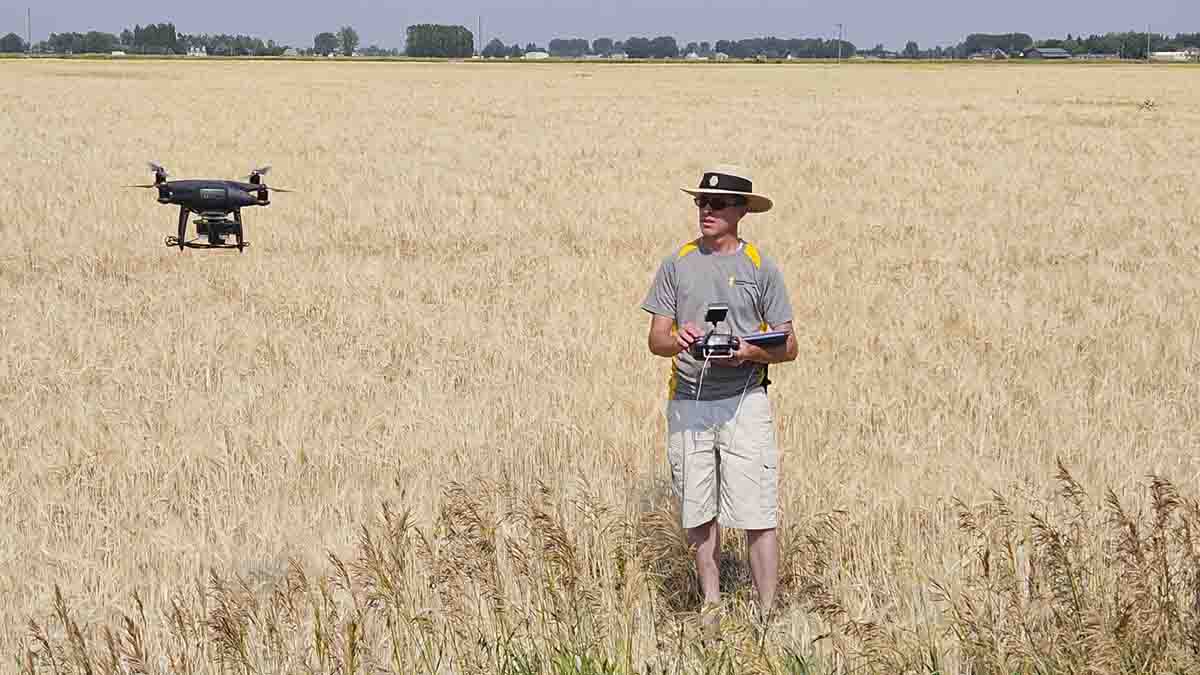Water-use Efficiency Study
September 04, 2024
University of Idaho researchers have been flying drones fitted with near-infrared cameras over eastern Idaho wheat and barley research plots to assess how efficiently different varieties use water.
Jared Gibbons and Lance Hansen, both UI Extension educators based in Madison County, earned a drone pilot’s license and recorded images over university cereal variety trials in Aberdeen, Idaho Falls and Tetonia from early June through late July, making at least three flights above each site.
“Are certain varieties of barley or wheat more efficient at using water than others? There really wasn’t anything that had been done to look at that across varieties, and it’s a tricky thing to measure because you’re talking about a very narrow band of how effective they are with water,” Gibbons said.
Gibbons came up with the idea as a means of finding uses for several small drones and a few larger drones his county office obtained for a program that teaches 4-H youth about drone technology. The project was funded with about $6,000 in Innovative Project Grant dollars through UI Extension. The cameras cost roughly $500 each and are about the size of a wallet.
“Those drones are capable of doing other things and I thought, ‘We’ve already got the drones. Let’s get more use out of them,’” Gibbons said.
Gibbons plans to review the data this fall. If he discovers statistically significant differences in water-use efficiency among varieties, he’ll share the information at cereal field days and include the data in an informational booklet about cereal varieties.
Healthy plants absorb most of the red light that’s visible to the human eye for use in photosynthesis and reflect near-infrared light, which isn’t part of the visible spectrum. As plants become stressed due to factors such as inadequate water, the balance shifts somewhat and they begin absorbing some near-infrared light.
Based on the reflection of near-infrared light, his software assigns a score ranging from -1 for dead plants or bare soil to 1 for perfectly healthy plants. Trial plots should work well for the experiment, given that they all receive the same amount of water, fertilizer and other inputs and are grown in replication in a common environment.
Gibbons plans to repeat the experiment next season if he generates conclusive data.
“I’m interested in doing this in dryland trials,” Gibbons said. “I think there’s potential to see more difference in the sites that are not irrigated.”
He also plans to evaluate how certain management practices affect water utilization, as well as the amount of water required for plants to convert certain forms of nitrogen into growth.
Furthermore, he’s already used the drones and cameras to aid colleagues’ research, including a project evaluating annual alfalfa as a means of fixing additional nitrogen and a project evaluating herbicide effectiveness.
“Now that I’ve got the cameras that’s a one-time cost and I can keep using them for other projects within the district,” Gibbons said.

About the University of Idaho
The University of Idaho, home of the Vandals, is Idaho’s land-grant, national research university. From its residential campus in Moscow, U of I serves the state of Idaho through educational centers in Boise, Coeur d’Alene and Idaho Falls, nine research and Extension centers, plus Extension offices in 42 counties. Home to more than 12,000 students statewide, U of I is a leader in student-centered learning and excels at interdisciplinary research, service to businesses and communities, and in advancing diversity, citizenship and global outreach. U of I competes in the Big Sky and Western Athletic conferences. Learn more at uidaho.edu.






